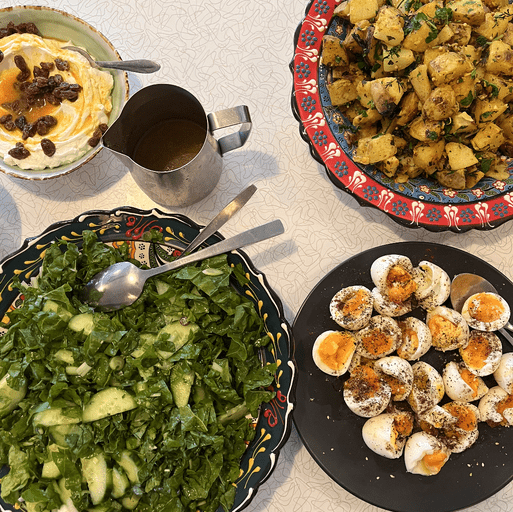
Middle Eastern Class December 12, 2021 RECIPES
MENU
Ta'ameia (fava bean felafel)
Muhamarra dip & Pita
Hummus two ways
Labneh & orange marinated raisins
Beetroot tzatziki
Salad-e shirazi: silverbeet, cucumber, onion with verjuice dressing
Herby Batata Harra
Koshari lentils
Slow-cooked Sicilian lamb shoulder
Yoghurt Flatbreads
Persian Love Cake
Ta'ameia
300g fava beans, peeled (soaked overnight)
1.5 cups of fresh coriander and parsley
¼ white onion, roughly chopped
1 garlic cloves, medium
1 tsp coriander
1 tsp salt
oil for deep frying
6 tbsp coriander seeds, for garnish
Steps:
Soak the fava beans overnight then drain very well. You want as little of the water to go into the final mixture.
In a food processor, add the fresh herbs, onion, garlic, coriander seeds, and salt. Blitz until almost a smooth paste (think of a wet sandy mixture).
Add the fava beans and pulse until kind of a sandy texture, but larger grains. Add the "garnishing" sesame and coriander seeds and pulse until mixed through. Place fava beans in the fridge until ready to use.
Pre-heat your oil to 175C.
Form the taameia into even balls by using the special taameia tool or slightly damp hands. Place them in a tray with baking paperor cook immediately.
Cook the taameia in batches for about 2-4 minutes or until golden brown all around. Place onto paper towel to absorb excess oil.
Muhamarra dip
4 large red peppers, roasted and peeled
2 cloves garlic, roughly chopped
mild red chilli, deseeded and chopped
150g walnuts, toasted, roughly chopped, plus 50g for garnish 2 teaspoons salt
2 tablespoons lemon juice
2 tablespoons pomegranate molasses 4 tablespoons olive oil
Steps:
Put all the ingredients except the lemon juice, pomegranate molasses, olive oil in a food processor and blend until very smooth.
Add the lemon juice and pomegranate molasses, blend further then slowly stream in the olive oil.
To serve: Spread a thick layer over a flat plate, making a dip in the middle. Fill the dip with the remaining olive oil, sprinkle with chopped walnuts.
Hummus two ways
First way (classic):
250g dried chickpeas, soaked overnight in water + 1 tsp of baking soda
1 tbsp salt, plus more for seasoning
270g tahina
60ml lemon juice 2 garlic cloves 100ml iced water
Steps:
Add your soaked chickpeas and 1 tbsp of salt into a pot and cover with water. Cook for about 30-40 minutes, making sure to skim the foam that appears on top, until the chickpeas are completely tender- you should be able to squish the chickpeas easily with no extra pressure.
Drain the chickpeas if using immediately, if not, keep it in the liquid to stay warm.
In a food processor, add the garlic, lemon juice and chickpeas (they should be warm!). Blitz it up until a relatively smooth paste is formed, depending on your food processor, anywhere between 3-5 minutes.
Now add the tahina and 1 tsp of salt and process until it’s mixed in, then slowly drizzle in the water, you may not need all of it. Start with half the water and check the consistency before adding more.
To serve:
![]() Spoon the hummus into a serving plate, adding a swoosh here and there
Spoon the hummus into a serving plate, adding a swoosh here and there
![]() Garnish with good olive oil
Garnish with good olive oil
Second way (fattet humus)
250g dried chickpeas, soaked overnight in water + 1 tsp of baking soda
1 tbsp salt, plus more for seasoning
270g tahina
60ml lemon juice 2 garlic cloves
150g greek yoghurt
100g warm chickpea liquid
3 pitas, torn into 2-3cm pieces and baked until golden
90ml olive oil
10g parsley leaves, finely chopped 10g coriander leaves, finely chopped 2 lemons, zest and juice both
1/2 tsp sumac 1/4 tsp paprika
Steps:
Follow classic humus recipe but keep the chickpeas in the warm liquid
To make pita chips: preheat oven to 180C. Mix pita pieces with 2 tbsp olive oil, pinch of salt, 1/2 tsp cumin, lay on a baking tray and bake for 10-20 minutes or until pita is golden and crispy.
To make the hummus: Place half the chickpeas, approximately 200g, in the food processor with the garlic and blitz until smooth paste. Add the yoghurt, Tahina, lemon juice, 1/2 tsp salt and blitz up. Add the warm liquid, half at first to check consistency.
To make the garnish: mix the chopped parsley, coriander, lemon zest, olive oil, and a small pinch of salt in a small bowl.
To serve:
In your serving dish, we’ll begin layering. Start with half the hummus, then two thirds of the chickpeas, 3 tbsp of the cooking liquid, hummus, pita, then finally chickpeas
Garnish with the herb oil and dust with sumac and paprika
Labneh and orange marinated raisins
750g thick greek yoghurt
1/2 cup raisins (mix of golden and black would be ideal) 100ml orange juice, or just enough to cover the raisins
Steps:
To make the labneh: Place the greek yoghurt in a cheese cloth, tie it with a string to compact it into a rough ball, and let it hang in your fridge above a container to catch the excess liquid. Leave it anywhere between 2-5 days. The longer you leave it, the thicker the labneh will turn out. I usually start with 2 days and check it daily.
When ready, transfer to a container and store in the fridge up to 7 days. Mix with a spoon to loosen slightly before using.
To make the marinated raisins: Mix the raisins and orange juice in a bowl and let it sit in the fridge for minimum 24 hours, and up to 48 hours.
To serve:
Swoosh the labneh onto a plate and garnish the raisins with a bit of the juice all around. Finish with some nice olive oil and black pepper
Beetroot tzatziki
The key to a great tzatziki is stripping the cucumber of all its moisture so it remains crunchy and fresh. We love the earthy sweetness that beetroot brings to this classic Greek dish.
200 g fresh beetroot (baby ones, if you can get them), trimmed
1 lebanese cucumber, grated
1 t salt
200 g natural Greek yoghurt 1 garlic clove, finely chopped 1 T lemon juice
Steps::
Preheat oven to 180C
Wrap each beetroot bulb in foil. Place on a baking tray and bake for 45-50 minutes until tender. Once cooled, grate the beetroot. (you can use a food processor to save your hands getting pink!)
Meanwhile, place the cucumber and salt in a colander and allow to drain for 10 minutes. Squeeze to remove excess liquid and place in a bowl.
Add remaining ingredients, stir to combine, and taste. Season as necessary with salt.
Store in the refrigerator no longer than 24 hours.
Note: if your beetroot has leaves attached, don’t throw them away! They are super tasty and good for your kidneys. Make a salad or sautee them with olive oil.
To serve:
![]() Spoon onto a nice serving dish, to be eaten cold or at room temp
Spoon onto a nice serving dish, to be eaten cold or at room temp
Batata harra
10 medium potatoes
6 tbsp ghee (clarified butter) or olive oil, to keep it vegan/dairy free
5 garlic cloves, minced 3 tsp coriander seeds
2 tsp chilli flakes
4 tsp turmeric powder
2 limes or lemons, juice and zest - save roughly 2 tsp for the garnish
2 cups fresh coriander (with stems), roughly chopped
1 cup parsley (with stems), roughly chopped
1 cup mint, roughly chopped
cup dill (with stems), roughly chopped
Method: Place the potatoes in a large pot with well salted cold water. Boil and cook for anywhere between 10-20 minutes until fully cooked through but still al dente.
Meanwhile, prepare all your herbs and mix them in a large bowl. Make sure not to bruise the herbs.
Drain and cool the potatoes and then chop them into bite-sized pieces. Add half the herbs and toss to coat
This next step might have to be done in two batches. In a cast-iron skillet or similar, add the ghee, garlic, chilli flakes, and coriander seeds. Cook until fragrant, about 2 minutes.
Add the turmeric powder and the juice and zest of the limes. Add the potatoes and leave it to develop a crust. Stir as little as possible. It's done when the potatoes are coated in all the aromatics and it has crispy bits around it.
In the bowl of herbs, add the olive oil and the remaining 2tsp lime juice and gently toss to coat.
salt to taste
2 tbsp olive oil, for garnish
To serve: transfer the potatoes into a several small/medium dishes garnish with the herb oil
Za'atar eggs
7 eggs
1 1/2 tbsp lemon juice 3 tbsp olive oil
1 tbsp za’atar
1 pinch chilli powder, like Aleppo 1 tsp sesame seeds
salt and black pepper
Steps:
Boil the eggs for 6.5 minutes then plunge into ice cold water to stop the cooking.
Break the eggs in half using your hands so you get nice scraggly and uneven pieces. Break them horizontally and vertically to create variety. Place on your serving plate.
In a small bowl, whisk the lemon juice, olive oil, za’atar, sesame seeds, and a pinch of salt. Drizzle it all over the eggs.
Finish with a sprinkling of chilli powder, garnishing salt, and black pepper
Koshari
300g lentils, soaked overnight, boiled until al dente, and drained
3 tbsp butter or olive oil 2 tsp cumin seeds
2 coriander powder 300g rice
1/2 tsp Sumac powder
1/2 tsp Cinnamon powder 1 tsp salt
2 spring onions, chopped
onions, sliced and fried till golden and crispy
Steps:
In a pot, add the butter or fat of choice. Once melted, add the
Add the rice and fry for about 5 minutes, making sure it is well coated in the fat and spices.
Now add the cinnamon, sumac, and salt and stir until well combined.
Cover with just enough water and leave to cook like any regular rice, about 20-25 minutes.
Once fully cooked, let it sit in the pot, off heat for another 15 minutes, then gently fluff with a fork or chopsticks.
Gently stir in the lentils, making sure not to overmix as rich can get really starchy and start to break down, making the mixture wet.
cumin and coriander and let toast for a minute.
To serve: transfer to a serving dish, garnish with a sprinkle of sumac and/or fresh herbs
Salad-e Shirazi
Named for the city in southwestern Iran, salad-e Shirazi is found on practically every Iranian table at practically every meal. It should be bright, crunchy and tart, a nice counterpoint to rich, buttery rice and unctuous stews. Toss the cucumbers, onion, herbs and chopped silverbeet with the lime vinaigrette just before serving to preserve their crunch. In Iran, dining companions usually fight over the leftover juice at the end of a meal.
Ingredients
3 to 4 Persian cucumbers or one telegraph
Green onions
2 tablespoons any combination of finely chopped fresh parsley, coriander, basil or dill and mint
Large bunch of silverbeet, stems removed and chopped
¼ cup verjuice
3 tablespoons extra-virgin olive oil
Fine sea salt and freshly ground black pepper
Preparation:
Remove alternating stripes of peel on cucumbers and trim ends. Dice cucumbers into 1/4-inch pieces and place in a large bowl with onion and fresh herbs. Finely slice the silverbeet and add to
Sicilian Slow-Cooked lamb
1 bone-in lamb shoulder (1.5-2 kg)
1/2 cup olive oil
5 garlic cloves, minced
2 T dried oregano leaves (or a bunch of fresh ones)
2 cups chicken stock
juice of 3 lemons
Steps: Generously salt the lamb. Place oil, garlic, black pepper and oregano in a large bowl. Mix well then coat the lamb with this. I then place the shoulder in a plastic ziplock bag for 24-48 hours in the fridge. When you're 4 hours away from eating it, place the shoulder in a heavy roasting pan. Pour the lemon/stock mix over the top, cover tightly with foil and roast at 180c (160 fan forced) for 3 hours. Take foil off and bake for another 30 minutes. This is also delicious reheated so can be made in advance.
Yoghurt Flatbreads
500 g self-rising flour
500 g Greek yoghurt
1 tsp baking powder
1 tsp salt
Steps:
Mix all of the ingredients in a bowl and let sit for about 15 minutes for the flour to hydrate.
Divide into 13 balls and flatten each piece with a rolling pin (you can make it round or oblong)
Cook the flatbreads in a really hot iron griddle or a pizza oven about 2-4 minutes each side depending on how hot the oven is.
Persian love cake
Think those golden baklava-ish flavours, but in a moist cake with sticky,
dark caramelised sides. This is a cake to make if you are usually bad at making cakes. Two plusses: it uses a muffin method (what I call a ‘bung-
in-and-stir’), which requires very little to no technique, and is a wonderful gluten-free option.
Crumb base:
300g almond meal
185g caster (superfine) sugar 220g soft brown sugar
120g unsalted butter, melted
Cake batter:
eggs, lightly beaten
250g natural or Greek-style yoghurt 1/8 tsp salt
1 tsp ground cardamom 2 tsp rosewater
25 saffron threads
3 tbsp flaked almonds
3 tbsp pistachio nut kernels, roughly chopped
Edible rose petals, for garnish
Steps:
Preheat the oven to 170°C fan-forced. Grease the ring of a 24cm (9½ inch) springform tin, then line with strips of baking paper. Turn the base upside down, so it no longer has a lip. Place a piece of baking paper over it, then clamp the ring around it to secure.
To make the crumb base, combine the almond meal, caster sugar, brown sugar and butter in a large mixing bowl, and rub together until you have an even, sandy consistency. Divide the mixture in two, and tip half into the prepared tin. Using the back of a spoon or a spatula, press the crumb mixture evenly over the bottom of the tin.
To make the cake batter, add the eggs, yoghurt, salt, cardamon, rosewater and saffron to the remaining crumb mixture and whisk until there are no lumps. Pour over the crumb base and sprinkle the flaked almonds and pistachio nuts over the top.
Bake for about 25 minutes until golden and fully risen – you will know because the top will probably crack a little. If the top is colouring too quickly, cover with foil, then bake for a further 20-30 minutes. The centre of the cake should spring back when pressed gently. Cool completely, before removing from the tin and cutting to serve.
Decorate with edible rose petals, and a very light dusting of icing sugar.


